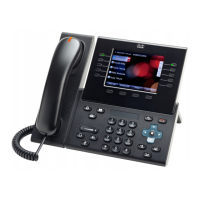10-13
Cisco Unified Wireless IP Phone 7925G Administration Guide for Cisco Unified Communications Manager 7.0(1)
OL-15984-01
Chapter 10 Troubleshooting the Cisco Unified Wireless IP Phone 7925G
Resolving Voice Quality and Roaming
Note Concealment ratio and concealment seconds are primary measurements based on frame loss while MOS
LQK scores project a “human-weighted” version of the same information on a scale from 5 (excellent)
to 1 (bad) for measuring listening quality.
Listening quality scores (MOS LQK) relate to the clarity or sound of the received voice signal.
Conversational quality scores (MOS CQ such as G.107) include impairment factors, such as delay, that
degrade the natural flow of conversation.
For information about configuring voice quality metrics for phones, refer to the “Phone Features”
section in the “Cisco
Unified IP Phone” chapter in Cisco Unified Communications Manager System
Guide.
You can access voice quality metrics remotely by using Streaming Statistics (see Chapter 9, “Monitoring
the Cisco Unified Wireless IP Phone Remotely.”
Using Voice Quality Metrics
To use the metrics for monitoring voice quality, note the typical scores under normal conditions of zero
packet loss, and use the metrics as a baseline for comparison.
It is important to distinguish significant changes from random changes in metrics. Significant changes
are scores that change about 0.2 MOS or greater and persist in calls that last longer than 30 seconds.
Conceal Ratio changes should indicate greater than 3 percent frame loss.
MOS LQK scores can vary based on the codec that the Cisco Unified IP Phone uses. The following
codecs provide these maximum MOS LQK scores under normal conditions with zero frame loss:
• G.711 codec gives 4.5 score
• G.729A/ AB gives 3.7 score
A Conceal Ratio of zero indicates that the IP network is delivering frames and packets on time with no
loss.
Troubleshooting Tips
When you observe significant and persistent changes to metrics, use Table 10-1 for general
troubleshooting information.
Ta b l e 10-1 Changes to Voice Quality Metrics
Metric Change Condition
MOS LQK scores decrease
significantly
Network impairment from packet loss or high jitter:
• Average MOS LQK decreases could indicate widespread and
uniform impairment.
• Individual MOS LQK decreases indicate bursty impairment.
Cross-check with Conceal Ratio and Conceal Seconds for evidence
of packet loss and jitter.
MOS LQK scores decrease
significantly
• Check to see if the phone is using a different codec than
expected (RxType and TxType).
• Check to see if the MOS LQK version changed after a firmware
upgrade.

